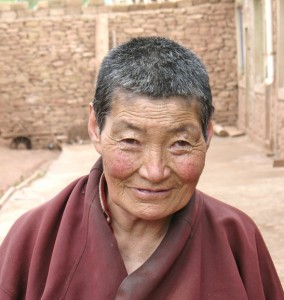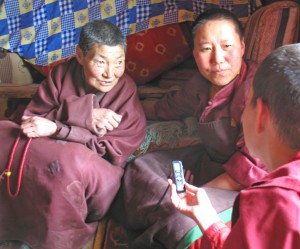
Takme Wangmo.
[Tamke Wangmo was 70 years old at the time of this interview in 2006. She passed away in July, 2012, with all the signs of a highly accomplished yogic practitioner. Read more here.]
I first entered Gebchak Nunnery when I was 12, during the time of Chodrak Gyamtso (the second Tsang-Yang Gyamtso[1] Rinpoche). Now I stay in the Jig-se[2] retreat division.
When I was about 18 years old I began my three-year retreat, during which we practiced a sadhana[3] of Guru Rinpoche along with tsa-lung and trul-kor[4]. A profound experience from the practice occurred for me and I had a clear vision of the eight manifestations of Guru Rinpoche. As a result of this vision my mind was deeply transformed.
Immediately following my three-year retreat the Cultural Revolution occurred and Gebchak Nunnery was completely destroyed. Most of the 700 nuns there at that time were killed or eventually starved to death. I managed to escape and fled to Lhasa, where I stayed with my family. Of course we weren’t allowed to do any visible Dharma practice during this time … But I relied on the Three Jewels in my mind and continued my practice internally, and in this way there were no obstacles for me.
When some religious freedom was regained in the late 1980’s, my family and I returned to Gebchak. About 30 older Gebchak nuns like me returned to help rebuild the Nunnery. We taught the new nuns the former traditions of practice – how to practice the Trolo sadhana (wrathful Guru Rinpoche), the manner of practicing in retreat, the chanting tradition and so forth. Nowadays there are only about seven of these white-haired, older nuns left at Gebchak. The rest have passed away.

Takme Wangmo being interviewed by Tenzin Chozom in 2006. © Gebchak Gonpa, Tibet.
Question: You and your family suffered greatly during the Cultural Revolution, and many of your loved ones were killed. How have you dealt with sorrow and anger?
Tamke Wangmo: Yes, there was a lot of suffering. Some of my relatives were killed, some died from starvation, but I understand that the nature of life is impermanent. I rely on my meditation practice and I don’t feel anger.
Q: Now, what is the essence of your practice?
Tamke Wangmo: My yidam is Jig-se[5]. Basically my practice is to pray to my lama, knowing that my lama’s mind and my own mind are inseparable, and to meditate on the awareness nature of mind.
When I was a young nun in Gebchak, the senior nuns who had accomplished their deities would go straight to the buddha-field when they died and remain in samadhi[6] for several days afterwards. That’s not all. In those days the nuns would practice tsa-lung and trul-kor sitting on the tops of high cliffs above a nearby river, and some of the nuns could fly across the river due to the power of their yogic accomplishments.
Q: How do you think Gebchak Nunnery can preserve this pure and profound lineage of accomplished nun-practitioners?
Tamke Wangmo: The nuns here are practicing the lineage of Ratna Lingpa, and both in and out of retreat the practice is maintained very well. But in order to maintain this practice lineage the food, clothing and shelter at this Nunnery are presently insufficient. We are all nuns, females, and the lamas of Gebchak are all still young, and therefore it is difficult for us to generate financial income. The nuns need improved conditions, particularly more food, so that they can remain in practice and in retreat year after year, day after day, dedicating their lives solely to accomplishing the Dharma. This is my hope. But I don’t know what the future will bring. How wonderful if it is possible, as it will allow this Dharma practice to continue.
As Milarepa said:
The meditator in retreat on the mountain
And the benefactor who provides his or her sustenance
Share the mutual karma to reach buddhahood at the same time
Due to the blessing of the heart of dependent-arising.
How wonderful it would be!
[1] Tsang-Yang Gyamtso: the founder of Gebchak Nunnery. The first Tsang-Yang Gyamtso was a heart disciple of the first Drubwang Tsoknyi Rinpoche.
[2] Jig-se: Skt, Bhairava, Tib, འཇིགས་བྱེད་. An form of Yamantaka which is the wrathful aspect of Manjushri – the Buddha of Wisdom.
[3] sadhana: Skt -‘Means of accomplishment’, Tib – སྒྲུབ་ཐབ།. Tantric liturgy and procedure for practice. The typical sadhana structure involves a preliminary part including the taking of refuge and arousing bodhichitta, a main part involving visualization of a buddha and recitation of the mantra, and a concluding part with dedication of merit to all sentient beings.
[4] tsa-lung and trul-kor: yogic methods which lead to the control of the internal channels and the vital energy
[5] yidam: personal meditational deity.
[6] samadhi: meditative absorption.
Note: Interview conducted in July, 2006, at Gebchak Gonpa, and translated by Tenzin Chozom.
- Read next interview.>>
- Back to Gebchak nuns.
